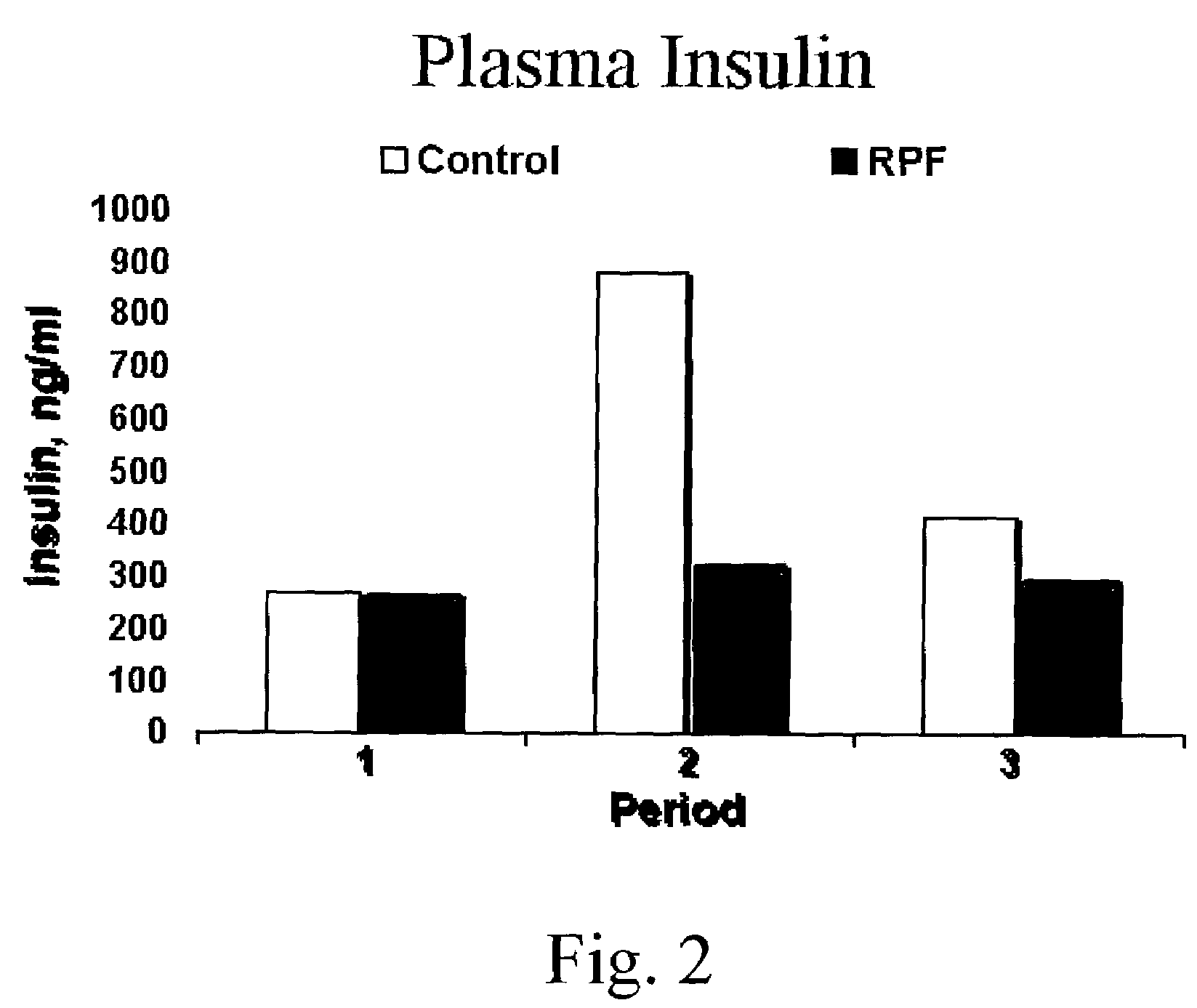Carbohydrate ruminant feed energy supplement and method
a ruminant feed and energy supplement technology, applied in the field of new postpartum ketosis preventative feed supplement and method, can solve the problems of limiting the uptake of glucose by tissues, reducing concentration, and not being very responsive to insulin in the adipose tissue of bovine adipose tissue, so as to prevent or alleviate the metabolic effects of negative energy balance and reduce the feed intake of ruminant animals
- Summary
- Abstract
- Description
- Claims
- Application Information
AI Technical Summary
Benefits of technology
Problems solved by technology
Method used
Image
Examples
experiment 1
[0032]Experimental design. Four mid-lactation Holstein cows were used in a 6 week trial. The cows were adapted to Calan Broadbent door feeders 2 weeks prior to the start of the trial. Diets were a total mixed ration consisting of corn silage, alfalfa, soybean meal (SBM), and hay. The experimental design was a double switch back. All cows received basal diet for 1 week, followed by either the basal diet plus corn starch or basal diet plus rumen protected fructose for 2 week periods. Fructose was introduced into the diet gradually, starting at 150 g / day and increasing daily by 150 g until 1 kg / day was fed throughout week 2 of each experimental period. The ruminally protected fructose product (RPF) contained 80% fructose by weight. There were three experimental periods. Two cows received rumen protected fructose during periods 1 and 3; the other two cows received rumen protected fructose during period 2.
[0033]Feed intakes and refusals were measured daily. At the end of each two-week pe...
experiment 2
[0035]Experimental design. Two cows in late-lactation, one Brown Swiss and one Holstein, prepared with ruminal cannulae were used to determine the ruminal dry matter disappearance rate of a rumen-protected fructose product (80% fructose), ground corn, and a 50:50 combination of these two feedstuffs. The experimental diet was typical of that fed to lactating dairy cows and is described in Table 1. Cows were milked and fed three times daily.
[0036]
TABLE 1Description of diet used for in situ fructoseruminal degradability.ItemIngredient% of DMAlfalfa haylage12.5Corn silage24.9High moisture corn18.5Ground dry corn10.2Corn distillers' grains8.72Whole cottonseed8.92Soybean meal, 44% CP8.28HI Energy 4-1913.39Pork meat and bone meal0.911Fish meal0.892Calcium carbonate0.775Sodium bicarbonate0.640Salt, sodium chloride0.446DY micro premix20.232XP-yeast30.213Magnesium oxide0.193Zinpro 4-plex40.058Vitamin E2020.038
[0037]In situ bags (10×20 cm, ANKOM Technology, Fairport, N.Y.) with pore sizes of 5...
experiment 3
[0040]Experimental design. Dietary treatments containing either ruminally protected fructose or corn starch were assigned randomly to 10 multiparous pregnant, nonlactating dairy cows before parturition. Starting 24 hours postpartum, treated cows were fed 1 kg / day of ruminally protected fructose, 80% fructose by weight, blended in a 0.5 kg of a liquid fat / molasses based supplement as a topdress upon their daily ration. Control cows received 1 kg / day of corn starch blended into 0.5 kg of the same liquid fat / molasses-based supplement containing. Treatments were continued for 7 days postpartum.
[0041]On days 5, 6, 7, 12, 13, and 14 of lactation blood samples were collected by tail venupuncture into 10 ml Vacutainer tubes (Beckton Dickenson) containing Na-EDTA. Samples were immediately placed upon ice until extraction of plasma by centrifugation and division into three aliquots which were frozen at −200 until determination of concentrations of glucose, β-hydroxybutyric acid (BHBA) and non...
PUM
 Login to View More
Login to View More Abstract
Description
Claims
Application Information
 Login to View More
Login to View More - R&D
- Intellectual Property
- Life Sciences
- Materials
- Tech Scout
- Unparalleled Data Quality
- Higher Quality Content
- 60% Fewer Hallucinations
Browse by: Latest US Patents, China's latest patents, Technical Efficacy Thesaurus, Application Domain, Technology Topic, Popular Technical Reports.
© 2025 PatSnap. All rights reserved.Legal|Privacy policy|Modern Slavery Act Transparency Statement|Sitemap|About US| Contact US: help@patsnap.com



